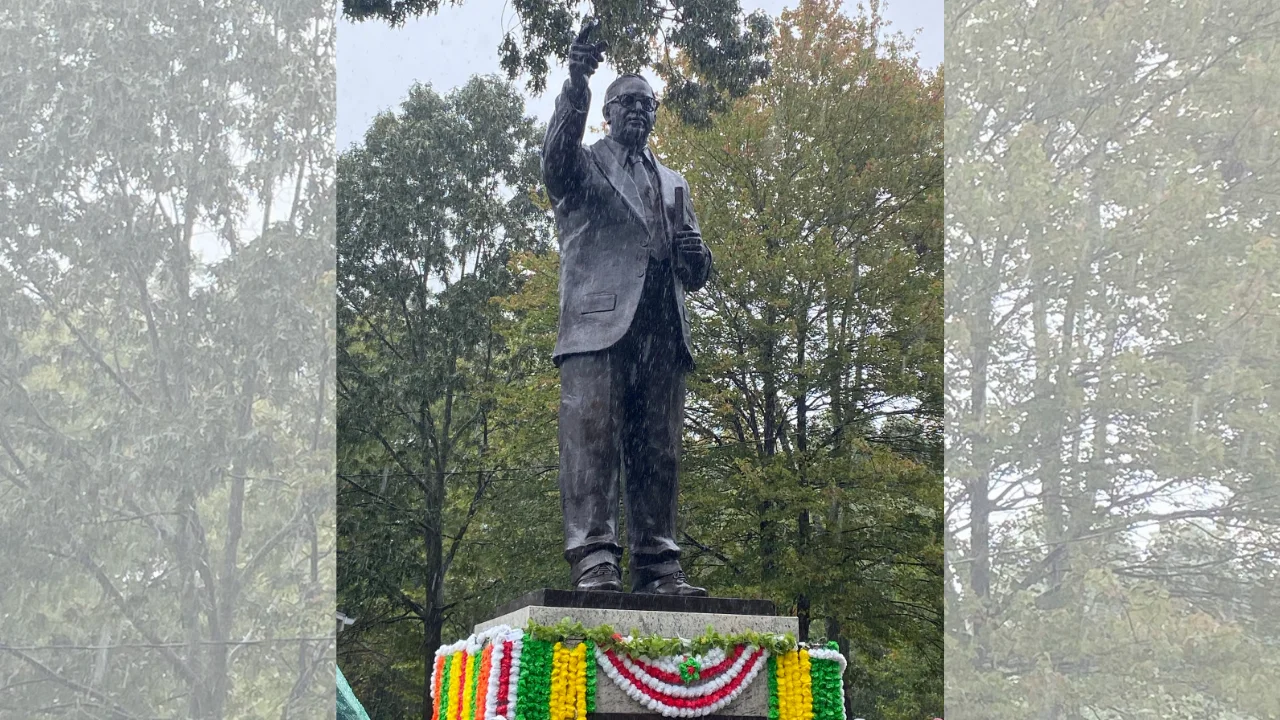The inauguration of a 19-foot tall statue of Dr. B.R. Ambedkar in Maryland, Washington, represents a historic and momentous occasion. Dr. B.R. Ambedkar, a key figure in India’s history, played a pivotal role in the framing of the Indian Constitution and the fight for social justice and equality. The statue is not only a symbol of his legacy but also a testament to the contributions of Indian-Americans and the broader Indian diaspora around the world.
Standing as the tallest statue of its kind outside of India, this remarkable sculpture serves as a powerful reminder of the enduring impact of Dr. Ambedkar’s ideas and the principles enshrined in the Indian Constitution. It is a testament to the ideals of justice, equality, and human rights that continue to inspire people globally. The statue is a significant step towards fostering cultural ties and strengthening the connection between India and its diaspora.
About the Tallest BR Ambedkar Statue
Inauguration
The enthusiastic chants of “Jai Bhim” during the inauguration ceremony and the presence of over 500 Indian-Americans from different parts of the United States, India, and other countries highlight the global respect and reverence for Dr. B.R. Ambedkar’s contributions. The event showcased the unity and solidarity among those who hold Dr. Ambedkar’s ideals close to their hearts.
Statue of Equality
Renowned sculptor Ram Sutar, known for creating the “Statue of Unity” in India, has crafted this magnificent statue, named the “Statue of Equality.” Its mission to address issues of inequality resonates not only in India but also on a global scale, as emphasized by Ram Kumar, President of the Ambedkar International Center (AIC).
Ambedkarite Movement in the US
Deelip Mhaske, a leader in the Ambedkarite movement in the United States, has aptly pointed out that the “Statue of Equality” symbolizes not just the 1.4 billion Indians but also the 4.5 million Indian Americans. The congratulatory messages from Prime Minister Narendra Modi and External Affairs Minister S. Jaishankar underscore the significance of this event in promoting unity and social justice, not only in India but also among the Indian diaspora worldwide. It stands as a testament to the enduring influence of Dr. Ambedkar’s vision.
About Dr. B.R. Ambedkar
Dr. Bhimrao Ramji Ambedkar (14 April 1891 – 6 December 1956) was an Indian jurist, economist, political leader, and social reformer who headed the committee drafting the Constitution of India from the Constituent Assembly debates, served as Law and Justice minister in the first cabinet of Jawaharlal Nehru, and inspired the Dalit Buddhist movement after renouncing Hinduism.
- Ambedkar was born into a Mahar family, a Hindu caste considered untouchable.
- He faced discrimination throughout his life, but he overcame these challenges to become one of the most influential leaders in Indian history.
- Ambedkar was a brilliant scholar.
- He earned a doctorate in economics from Columbia University and a law degree from the University of London.
- He also studied at the University of Bonn and the University of Gray’s Inn.
- Ambedkar was a prolific writer and speaker.
- He wrote extensively on law, economics, and social reform.
- He was also a founding member of the Bahishkrit Hitakarini Sabha, a Dalit rights organization.
Ambedkar died in 1956 at the age of 65. He is remembered as one of the greatest leaders in Indian history. He fought for the rights of Dalits and other marginalized groups, and he helped to create a more just and equitable society.
Ambedkar’s Contribution
Ambedkar played a key role in the Indian independence movement. He was a vocal critic of the caste system and advocated for the rights of Dalits. He also campaigned for the inclusion of Dalits in the Indian constitution.
- After India gained independence in 1947, Ambedkar was appointed Law and Justice Minister in the first cabinet of Jawaharlal Nehru.
- He was responsible for drafting the Constitution of India, which is considered one of the most progressive constitutions in the world.
- Ambedkar resigned from the cabinet in 1951 in protest of the government’s failure to implement social reforms.
- He converted to Buddhism in 1956, along with hundreds of thousands of his followers.
Ambedkar is a role model for people all over the world. He showed that it is possible to overcome adversity and achieve great things. He also taught us that we must all fight for justice and equality.
14th October – Dhamma Chakra Parivartan Din
Dhamma Chakra Parivartan Din is a Buddhist festival in India that commemorates the conversion of Dr. B.R. Ambedkar and his approximately 600,000 followers to Buddhism on 14 October 1956 at Deekshabhoomi, Nagpur.
The word “Dhamma” refers to the teachings of the Buddha, and “Chakra” refers to the wheel. “Parivartan” means “revolution” or “change.” Thus, Dhamma Chakra Parivartan Din is a celebration of the Buddhist revolution that Ambedkar led.
- Ambedkar faced discrimination and oppression throughout his life, and he eventually came to believe that Buddhism was the only religion that could offer Dalits true equality.
- On 14 October 1956, Ambedkar and his followers gathered at Deekshabhoomi in Nagpur to renounce Hinduism and convert to Buddhism.
- This was a historic event that marked a major turning point in the history of Buddhism in India.
- Dhamma Chakra Parivartan Din is a day of celebration for Buddhists around the world.
- It is a day to remember Ambedkar’s legacy and his commitment to social justice.
Dhamma Chakra Parivartan Din is a reminder that Buddhism is a religion that is open to all people, regardless of their caste, religion, or social status. It is a day to celebrate the diversity of the Buddhist faith and the commitment of Buddhists to social justice.
- Weekly Current Affairs 2025 PDF For Bank, SSC, UPSC Exams
- Unsung Heroes of India: 10 Unknown Freedom Fighters You Should Know
- 26 December Current Affairs 2023 in English
- Daily Current Affairs 2025, Check Today’s Current Affairs
- April Month Current Affairs 2024, Download PDF
- June Month Current Affairs 2024, Download PDF

Hello, I’m Aditi, the creative mind behind the words at Oliveboard. As a content writer specializing in state-level exams, my mission is to unravel the complexities of exam information, ensuring aspiring candidates find clarity and confidence. Having walked the path of an aspirant myself, I bring a unique perspective to my work, crafting accessible content on Exam Notifications, Admit Cards, and Results.
At Oliveboard, I play a crucial role in empowering candidates throughout their exam journey. My dedication lies in making the seemingly daunting process not only understandable but also rewarding. Join me as I break down barriers in exam preparation, providing timely insights and valuable resources. Let’s navigate the path to success together, one well-informed step at a time.






